Mapping Potential for Improving Rural Energy Services in Kyrgyzstan: Factors for Achieving Sustainable Development Goals in the Community Context
Abstract
:1. Introduction
1.1. Setting the Stage
1.2. Localizing Sustainable Development Goals in Kyrgyzstan
- Subgoal 7.1: By 2030, ensure universal access to affordable, reliable, and modern energy services.
- Subgoal 7.2: By 2030, increase substantially the share of renewable energy in the global energy mix.
- Subgoal 7.3: By 2030, double the global rate of improvement in energy efficiency.
1.3. Visualizing the Gap in the Research and Research Objectives
- Map the energy landscape of rural Kyrgyzstan based on the author’s on-site visit, literature review, and statistical data.
- Derivation of key driving factors which have an impact (direct or indirect) on the energy services in rural areas.
- Identification of a potential solution nexus to foster energy services in rural Kyrgyzstan.
2. Research Methodology
3. Energy Outlook of Rural Kyrgyzstan
3.1. Energy Demand
3.2. Energy Sources
3.3. Energy Carrier/Usable Energy Form
4. Factor Analysis for Improving Rural Energy Services
External–Internal Driving Factors
5. Solution Nexus to Improve Rural Energy Services
6. Conclusions
Author Contributions
Funding
Informed Consent Statement
Data Availability Statement
Conflicts of Interest
References
- United Nations. The 2030 Agenda and the Sustainable Development Goals: An Opportunity for Latin America and the Caribbean; United Nations, ECLAC: Santiago, Chile, 2018; ISBN 978-92-1-058644-3. [Google Scholar]
- Mehta, K.; Ehrenwirth, M.; Trinkl, C.; Zörner, W.; Greenough, R. The Energy Situation in Central Asia: A Comprehensive Energy Review Focusing on Rural Areas. Energies 2021, 14, 2805. [Google Scholar] [CrossRef]
- Mehta, K.; Ehrenwirth, M.; Missall, S.; Degembaeva, N.; Akmatov, K.; Zörner, W. Energy Profiling of a High-Altitude Kyrgyz Community: Challenges and Motivations to Preserve Floodplain Ecosystems Based on Household Survey. Sustainability 2021, 13, 13086. [Google Scholar] [CrossRef]
- NSC. Kyrgyzstan: Brief Statistical Handbook; Annual Publication; National Statistical Committee of the Kyrgyz Republic: Bishkek, Kyrgyzstan, 2018; Available online: http://www.stat.kg/media/publicationarchive/16db2910-6b8d-48f9-80b9-45b7ac3347bd.pdf (accessed on 22 September 2021).
- IEA. Kyrgyzstan Energy Profile: Country Report. Available online: https://www.iea.org/reports/kyrgyzstan-energy-profile (accessed on 5 June 2021).
- Sagynbekova, L. Environment, Rural Livelihoods, and Labor Migration: A Case Study in Central Kyrgyzstan. Mt. Res. Dev. 2017, 37, 456. [Google Scholar] [CrossRef]
- Sabyrbekov, R.; Ukueva, N. Transitions from dirty to clean energy in low-income countries: Insights from Kyrgyzstan. Cent. Asian Surv. 2019, 38, 255–274. [Google Scholar] [CrossRef]
- Lauermann, M.; Betz, F.; Mehta, K.; Thevs, N.; Ehrenwirth, M.; Zörner, W.; Cyffka, B. Preservation of Selected Ecosystem Services in the Floodplains of the Naryn River (Kyrgyzstan): Introducing the ÖkoFlussPlan Project. In Preservation of Selected Ecosystem Services; Geographica Augustana: Heidelberg, Germany, 2020; pp. 47–53. ISBN 1862-8680. [Google Scholar]
- Brakema, E.A.; Tabyshova, A.; Kasteleyn, M.J.; Molendijk, E.; van der Kleij, R.M.J.J.; van Boven, J.F.M.; Emilov, B.; Akmatalieva, M.; Mademilov, M.; Numans, M.E.; et al. High COPD prevalence at high altitude: Does household air pollution play a role? Eur. Respir. J. 2019, 53, 1801193. [Google Scholar] [CrossRef] [PubMed]
- Liu, M.F.; Pistorius, T. Coping with the energy crisis: Impact assessment and potentials of non-traditional renewable energy in rural Kyrgyzstan. Energy Policy 2012, 44, 130–139. [Google Scholar] [CrossRef]
- Laldjebaev, M.; Isaev, R.; Saukhimov, A. Renewable energy in Central Asia: An overview of potentials, deployment, outlook, and barriers. Energy Rep. 2021, 7, 3125–3136. [Google Scholar] [CrossRef]
- Sachs, J.D.; Lafortune, G.; Kroll, C.; Fuller, G.; Woelm, F. Sustainable Development Report 2022: From Crisis to Sustainable Development: The SDGs as Roadmap to 2030 and Beyond Includs the SDG Index and Dashboards. Available online: https://s3.amazonaws.com/sustainabledevelopment.report/2022/2022-sustainable-development-report.pdf (accessed on 9 June 2022).
- He, J.; Yang, Y.; Liao, Z.; Xu, A.; Fang, K. Linking SDG 7 to assess the renewable energy footprint of nations by 2030. Appl. Energy 2022, 317, 119167. [Google Scholar] [CrossRef]
- Radka, M. Issue Brief: SDG 7. Available online: https://wedocs.unep.org/bitstream/handle/20.500.11822/25762/SDG7_Brief.pdf?sequence=1&isAllowed=y (accessed on 1 June 2022).
- Eras-Almeida, A.A.; Egido-Aguilera, M.A. What Is Still Necessary for Supporting the SDG7 in the Most Vulnerable Contexts? Sustainability 2020, 12, 7184. [Google Scholar] [CrossRef]
- Laumann, F.; von Kügelgen, J.; Kanashiro Uehara, T.H.; Barahona, M. Complex interlinkages, key objectives, and nexuses among the Sustainable Development Goals and climate change: A network analysis. Lancet Planet. Health 2022, 6, e422–e430. [Google Scholar] [CrossRef]
- McCollum, D.; Echeverri, L.G.; Riahi, K.; Parkinson, S. SDG 7 Ensure Access to Affordable, Reliable, Sustainable and Modern Energy for All. Available online: https://pure.iiasa.ac.at/id/eprint/14621/1/SDGs-interactions-7-clean-energy.pdf (accessed on 5 June 2022).
- Madurai Elavarasan, R.; Pugazhendhi, R.; Jamal, T.; Dyduch, J.; Arif, M.T.; Manoj Kumar, N.; Shafiullah, G.M.; Chopra, S.S.; Nadarajah, M. Envisioning the UN Sustainable Development Goals (SDGs) through the lens of energy sustainability (SDG 7) in the post-COVID-19 world. Appl. Energy 2021, 292, 116665. [Google Scholar] [CrossRef]
- McCollum, D.L.; Echeverri, L.G.; Busch, S.; Pachauri, S.; Parkinson, S.; Rogelj, J.; Krey, V.; Minx, J.C.; Nilsson, M.; Stevance, A.-S.; et al. Connecting the sustainable development goals by their energy inter-linkages. Environ. Res. Lett. 2018, 13, 33006. [Google Scholar] [CrossRef]
- Naumann, M.; Rudolph, D. Conceptualizing rural energy transitions: Energizing rural studies, ruralizing energy research. J. Rural. Stud. 2020, 73, 97–104. [Google Scholar] [CrossRef]
- Sy, S.A.; Mokaddem, L. Energy poverty in developing countries: A review of the concept and its measurements. Energy Res. Soc. Sci. 2022, 89, 102562. [Google Scholar] [CrossRef]
- Rehman, I.H.; Kar, A.; Raven, R.; Singh, D.; Tiwari, J.; Jha, R.; Sinha, P.K.; Mirza, A. Rural energy transitions in developing countries: A case of the Uttam Urja initiative in India. Environ. Sci. Policy 2010, 13, 303–311. [Google Scholar] [CrossRef]
- Elsevier. Scopus Preview. Available online: https://www.scopus.com/home.uri (accessed on 5 June 2021).
- Van Eck, N.J.; Waltman, L. Software survey: VOSviewer, a computer program for bibliometric mapping. Scientometrics 2010, 84, 523–538. [Google Scholar] [CrossRef]
- Balabanyan, A.; Hofer, K.; Finn, J.; Hankinson, D. Keeping Warm: Urban Heating Options in the Kyrgyz Republic: Summary Report (English), Washington, DC. 2015. Available online: http://documents.worldbank.org/curated/en/555021468011161504/pdf/97409-WP-P133058-Box391503B-PUBLIC-Heating-Assessment-for-Kyrgyz-P133058-Final.pdf (accessed on 27 November 2021).
- Mehta, K.; Ehrenwirth, M.; Trinkl, C.; Zörner, W.; Greenough, R. Impact of Locally Available Thermal Insulation Structures on Space Heating Demand of High-altitude Rural Buildings: A Case Study of Kyrgyzstan. In Proceedings of the EuroSun 2020, Virtual Conference, 1–3 September 2020. [Google Scholar]
- IHA. Hydropower Status Report: Sector Trends and Insights, England. 2021. Available online: https://assets-global.website-files.com/5f749e4b9399c80b5e421384/60c2207c71746c499c0cd297_2021%20Hydropower%20Status%20Report%20-%20International%20Hydropower%20Association%20Reduced%20file%20size.pdf (accessed on 22 May 2021).
- Gassner, K.B.; Rosenthal, N.; Hankinson, D.J. Analysis of the Kyrgyz Republic’s Energy Sector: Final Report. World Bank Energy and Extractives Global Practice ECA Region. 2017. Available online: https://openknowledge.worldbank.org/handle/10986/29045 (accessed on 20 September 2021).
- Kim, E.; Standal, K. Empowered by electricity? The political economy of gender and energy in rural Naryn. Gend. Technol. Dev. 2019, 23, 1–18. [Google Scholar] [CrossRef]
- The Government of the Kyrgyz Republic, Voluntary National Review on the Implementation of the Sustainable Development Goals in the Kyrgyz Republic, Bishkek, Kyrgyzstan. 2020. Available online: https://sustainabledevelopment.un.org/content/documents/26459VNR_2020_Kyrgyzstan_Report_English.pdf (accessed on 11 June 2021).
- MEI. Microfinancing Household Insulation and Heating Measures in Kyrgyzstan: An Assessment Study by MicroEnergy International for Deutsche Gesellschaft für Internationale Zusammenarbeit GmbH, Berlin (Germany). 2013. Available online: https://eba.klink.asia/klink/ccf9ca/download (accessed on 25 January 2021).
- Bakashova, A.; Jorritsma, F.; Choitonbaeva, A.; Wendland, C. Opportunities to Stimulate Local Economies through Sustainable Innovations for Home Comfort: Gender-Sensitive Feasibility Study for Rural Areas in Issyk Kul and Naryn. 2013. Available online: http://www.womenforclimate.org/english/publications/2013/homecomforts-publication.php (accessed on 20 March 2021).
- World Bank. Fueling Kyrgyzstan’s Transition to Clean Household Heating Solutions; World Bank: Washington, DC, USA, 2020. [Google Scholar]
- Humanitarian OpenStreetMap Team. Kyrgyzstan Map. Available online: https://export.hotosm.org/en/v3/ (accessed on 1 June 2021).
- U.S. Geological Survey. Digital Elevation. Available online: https://www.usgs.gov/products/data-and-tools/data-and-tools-topics (accessed on 1 June 2021).
- Fick, S.E.; Hijmans, R.J. WorldClim 2: New 1-km spatial resolution climate surfaces for global land areas. Int. J. Climatol. 2017, 37, 4302–4315. [Google Scholar] [CrossRef]
- Solargis. Solar Resource Maps of Kyrgyz Republic. Available online: https://solargis.com/maps-and-gis-data/download/kyrgyz-republic (accessed on 1 June 2021).
- Sonntag, C. The nexus of settlement development and today’s energy use in Sary-Mogol, Alai Valley, Kyrgyzstan. Erdkunde 2016, 70, 153–168. [Google Scholar] [CrossRef]
- FAO. National Gender Profile of Agricultural and Rural livelihoods—Kyrgyz Republic: Country Gender Assessment Series, Ankara (Turkey). 2016. Available online: http://www.fao.org/3/a-i5763e.pdf (accessed on 20 August 2018).
- Beringer, J.; Mehta, K.; Ehrenwirth, M.; Zörner, W. Sustainable materials for insulating high-altitude rural Kyrgyz residential houses: A parametric economic study. In Proceedings of the Applied Research Conference 2021 Ostbayerische Technische Hochschule Amberg-Weiden, Virtual Conference, 23 July 2021. [Google Scholar]
- Laldjebaev, M. Energy Security, Poverty and Sovereignty in Mountain Communities of Tajikistan. Ph.D. Thesis, Cornell University, New York, NY, USA, 2017. [Google Scholar]
- Mehta, K.; Ehrenwirth, M.; Trinkl, C.; Zörner, W. Towards Sustainable Community Development through Renewable Energies in Kyrgyzstan: A Detailed Assessment and Outlook. World 2022, 3, 327–343. [Google Scholar] [CrossRef]
- Mehta, K.; Ehrenwirth, M.; Trinkl, C.; Zörner, W.; Greenough, R. A Parametric Study on the Feasibility of Solar-thermal Space Heating and Hot Water Preparation under Cold Climates in Central Asian Rural Areas. In Proceedings of the ISES EuroSun 2020 Conference—13th International Conference on Solar Energy for Buildings and Industry, EuroSun 2020, Online, 1–3 September 2020; Charalambides, A., Streicher, W., Mugnier, D., Eds.; International Solar Energy Society: Freiburg, Germany, 2020; pp. 1–12, ISBN 978-3-9820408-2-0. [Google Scholar]
- Treichel, C.; Cruickshank, C.A. Analysis of a Coupled Air-Based Solar Collector and Heat Pump Water Heater in Canada and the United States. In Proceedings of the ISES Solar World Congress 2019/IEA SHC International Conference on Solar Heating and Cooling for Buildings and Industry 2019, Santiago, Chile, 4–7 November 2019; Renné, D., Mugnier, D., Cardemil, J.-M., Guthrie, K., Rüther, R., Eds.; International Solar Energy Society: Freiburg, Germany, 2019; pp. 1–12, ISBN 978-3-9820408-1-3. [Google Scholar]
- Choudhury, P.K.; Baruah, D.C. Solar air heater for residential space heating. Energy Ecol. Environ. 2017, 2, 387–403. [Google Scholar] [CrossRef]
- Boronbaev, E. Energy saving Architecture: Background, Theory and Practice in Kyrgyzstan. E3S Web Conf. 2020, 172, 19010. [Google Scholar] [CrossRef]
- Mehta, K.; Mingaleva, E.; Zörner, W.; Degembaeva, N.; Baibagyshov, E. Comprehensive analysis of the energy legislative framework of Kyrgyzstan: Investigation to develop a roadmap of Kyrgyz renewable energy sector. Clean. Energy Syst. 2022, 2, 100013. [Google Scholar] [CrossRef]
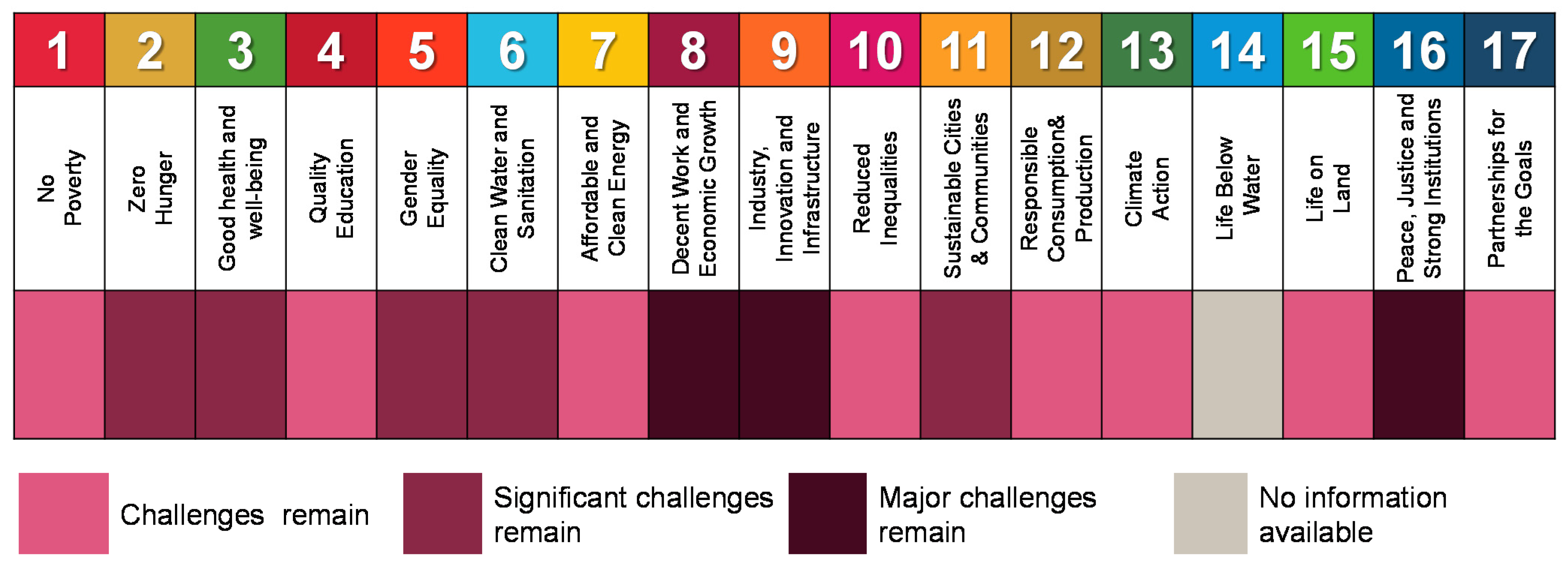
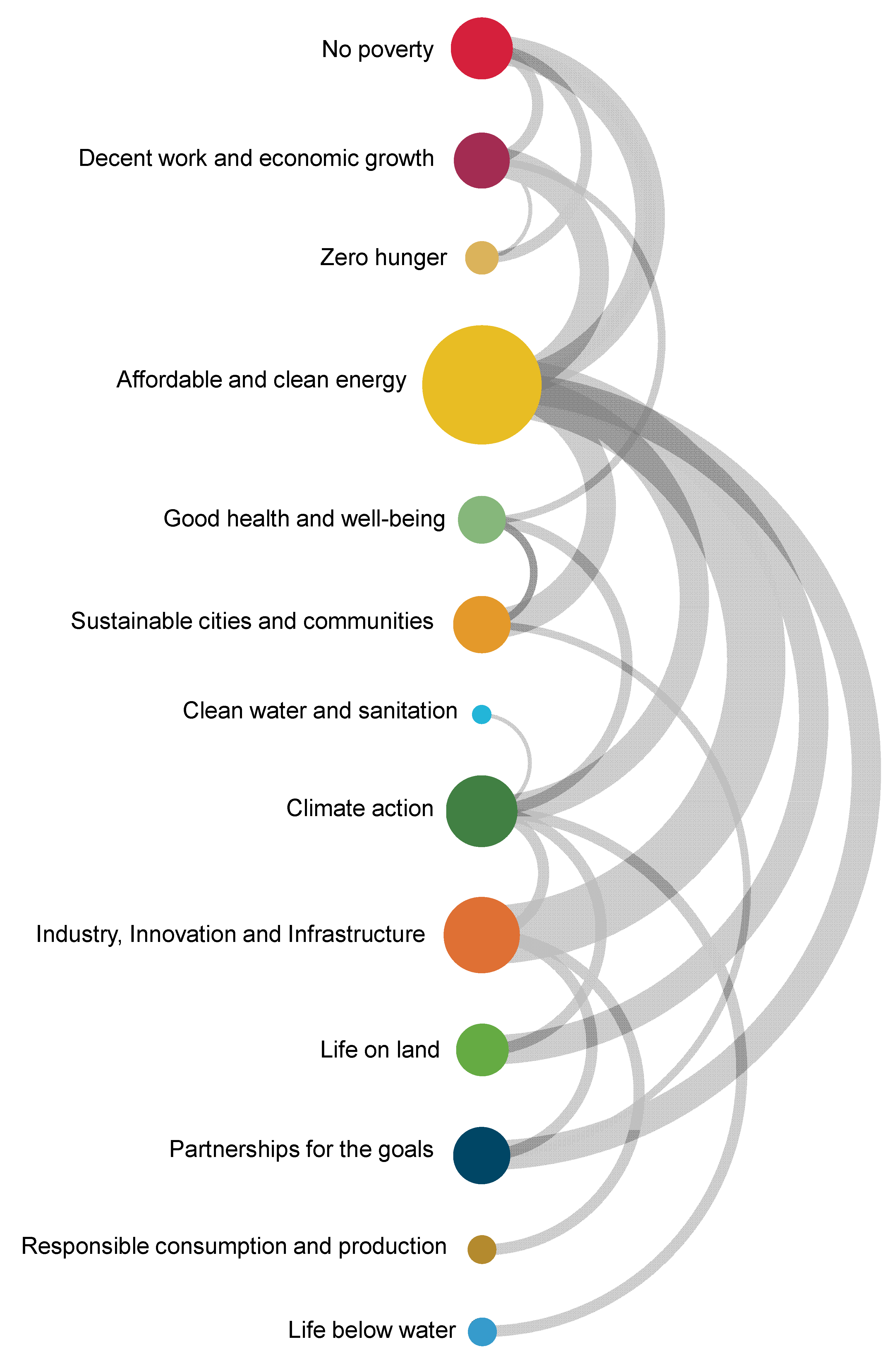
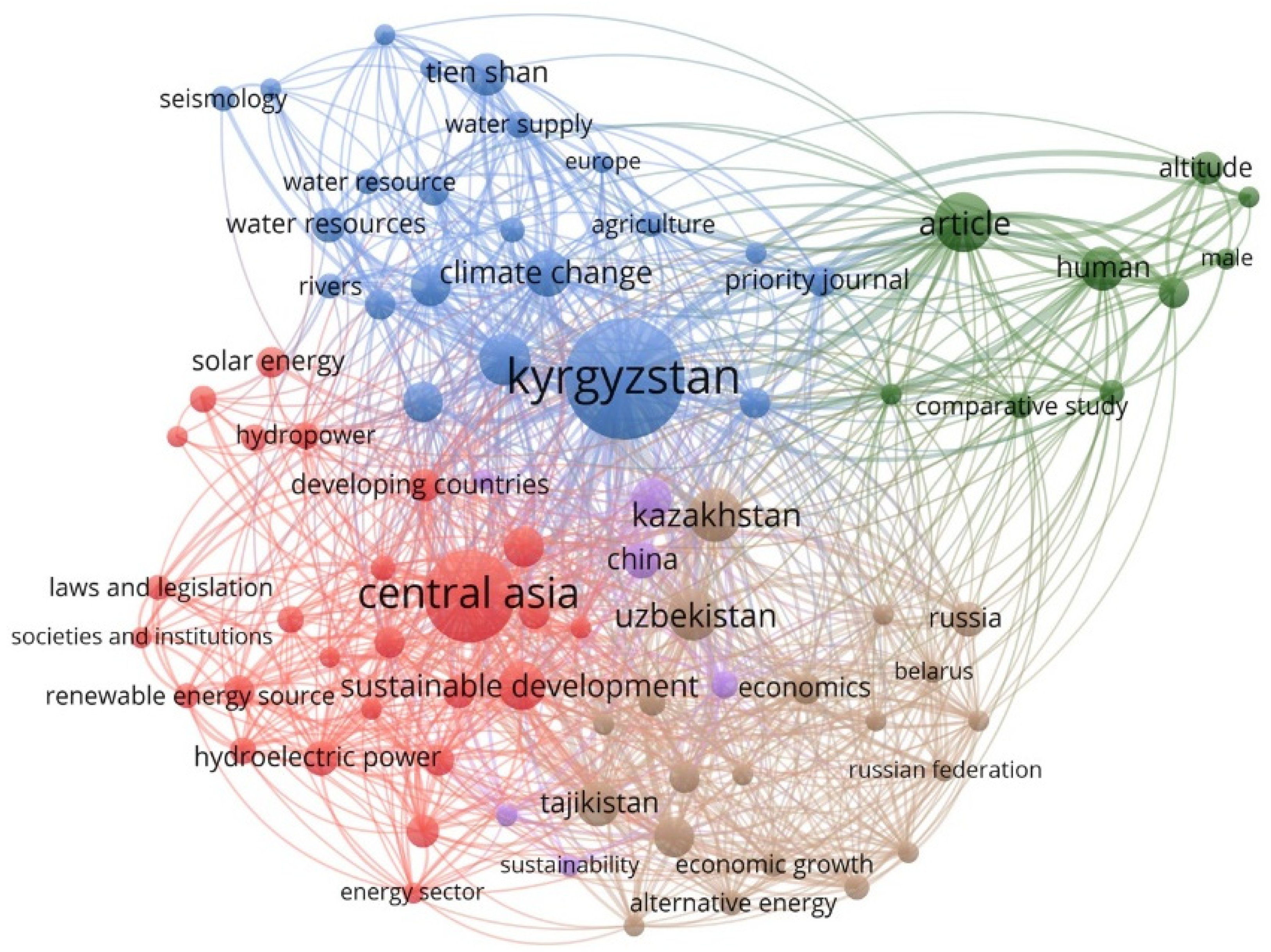
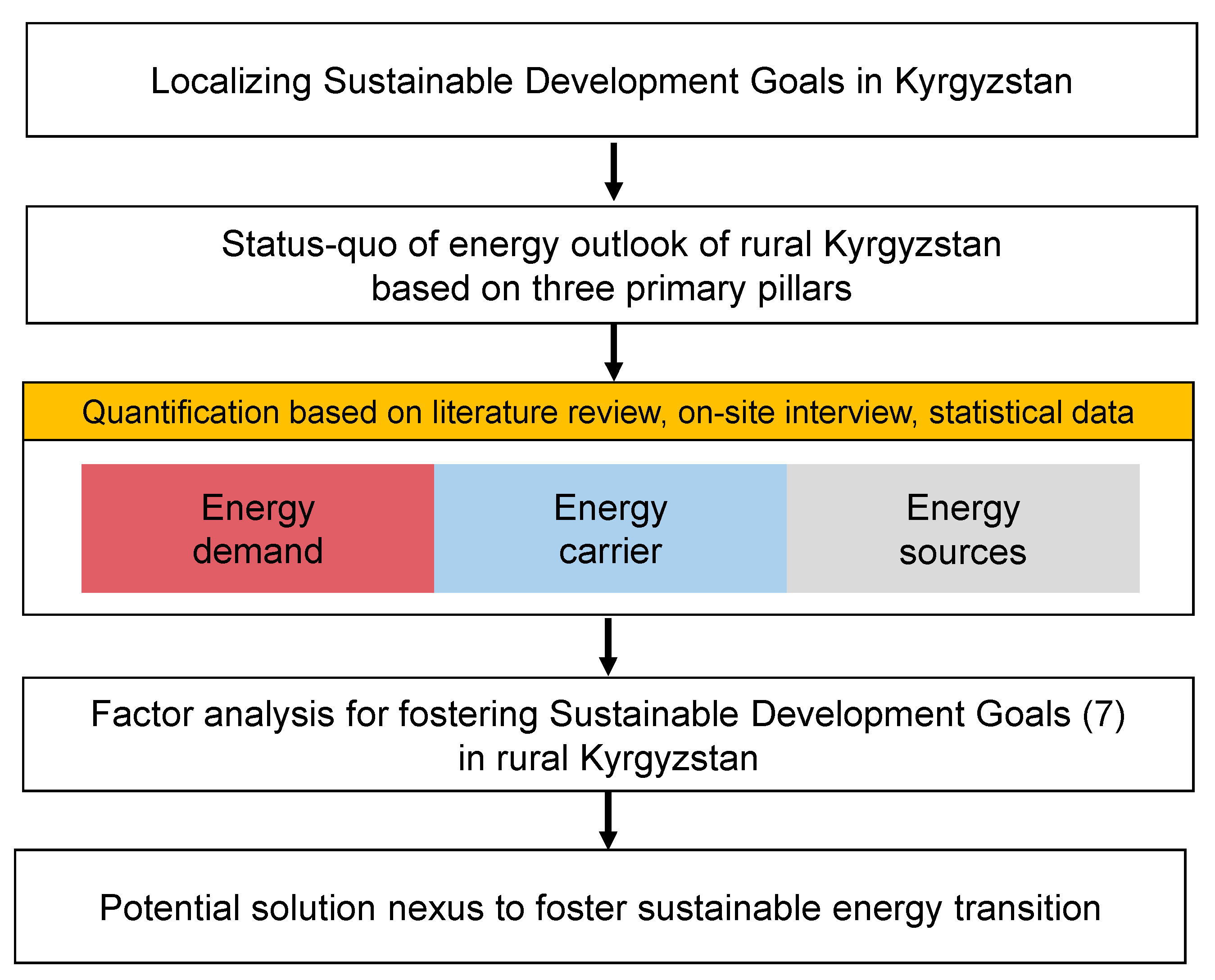
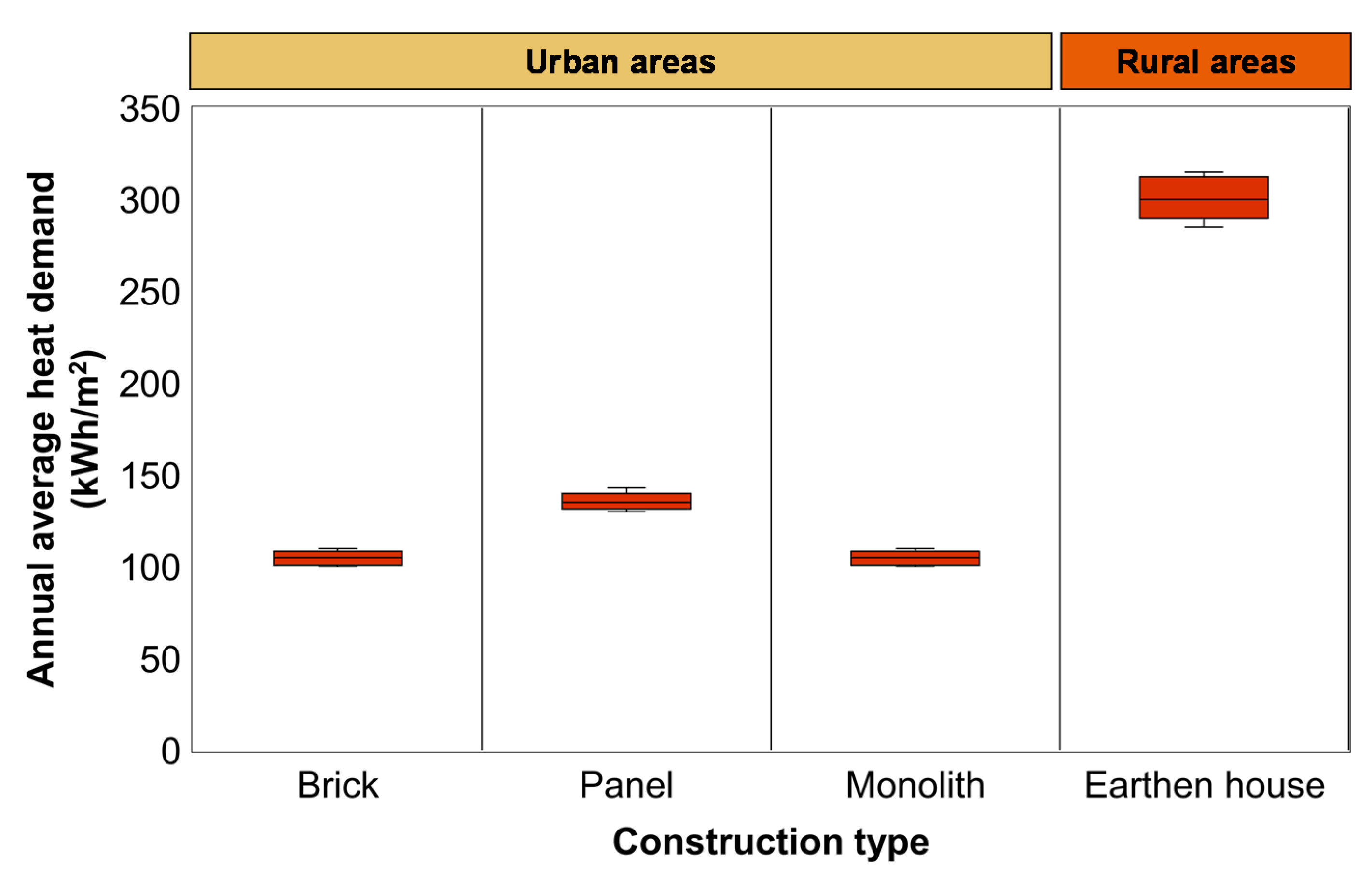
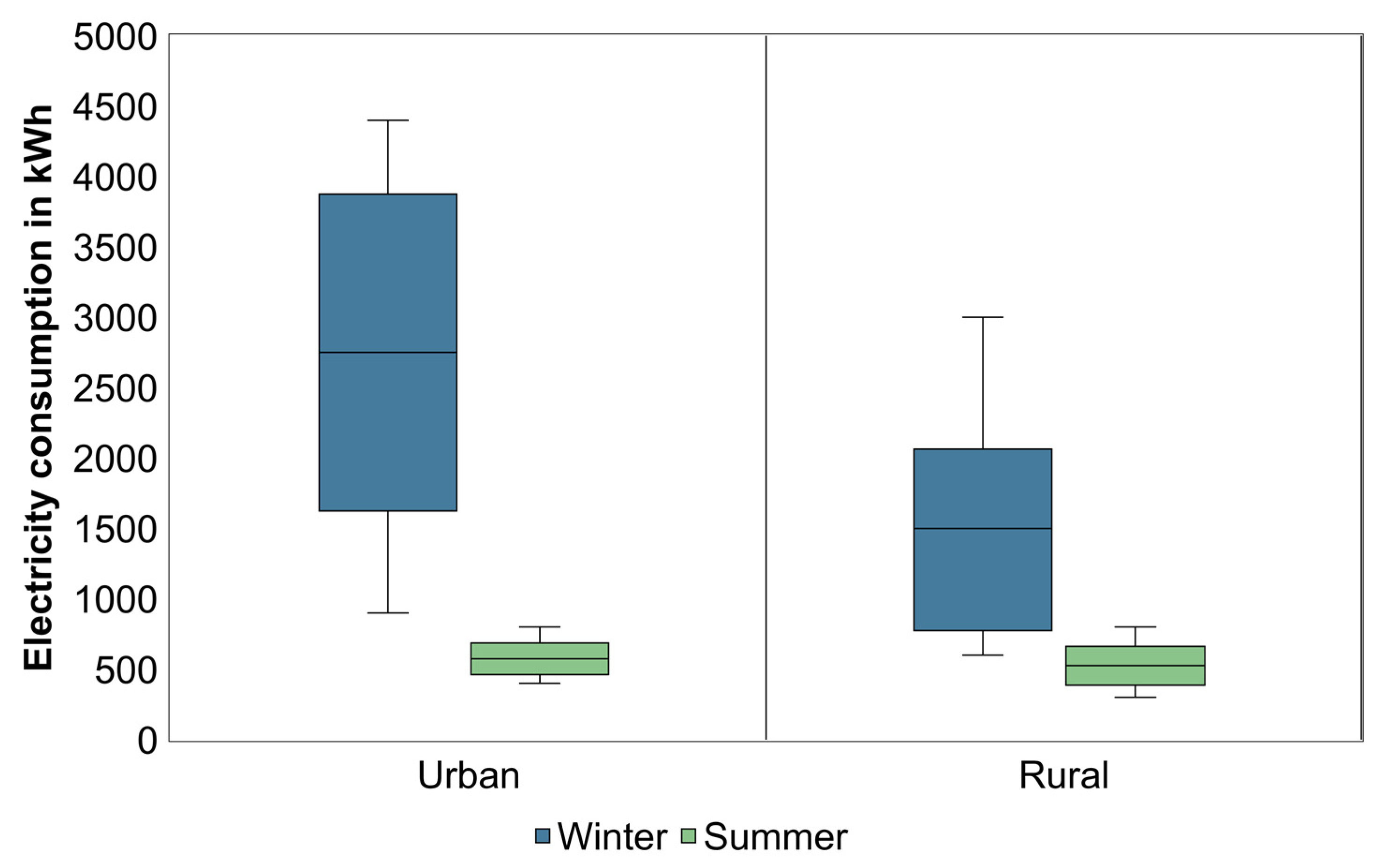
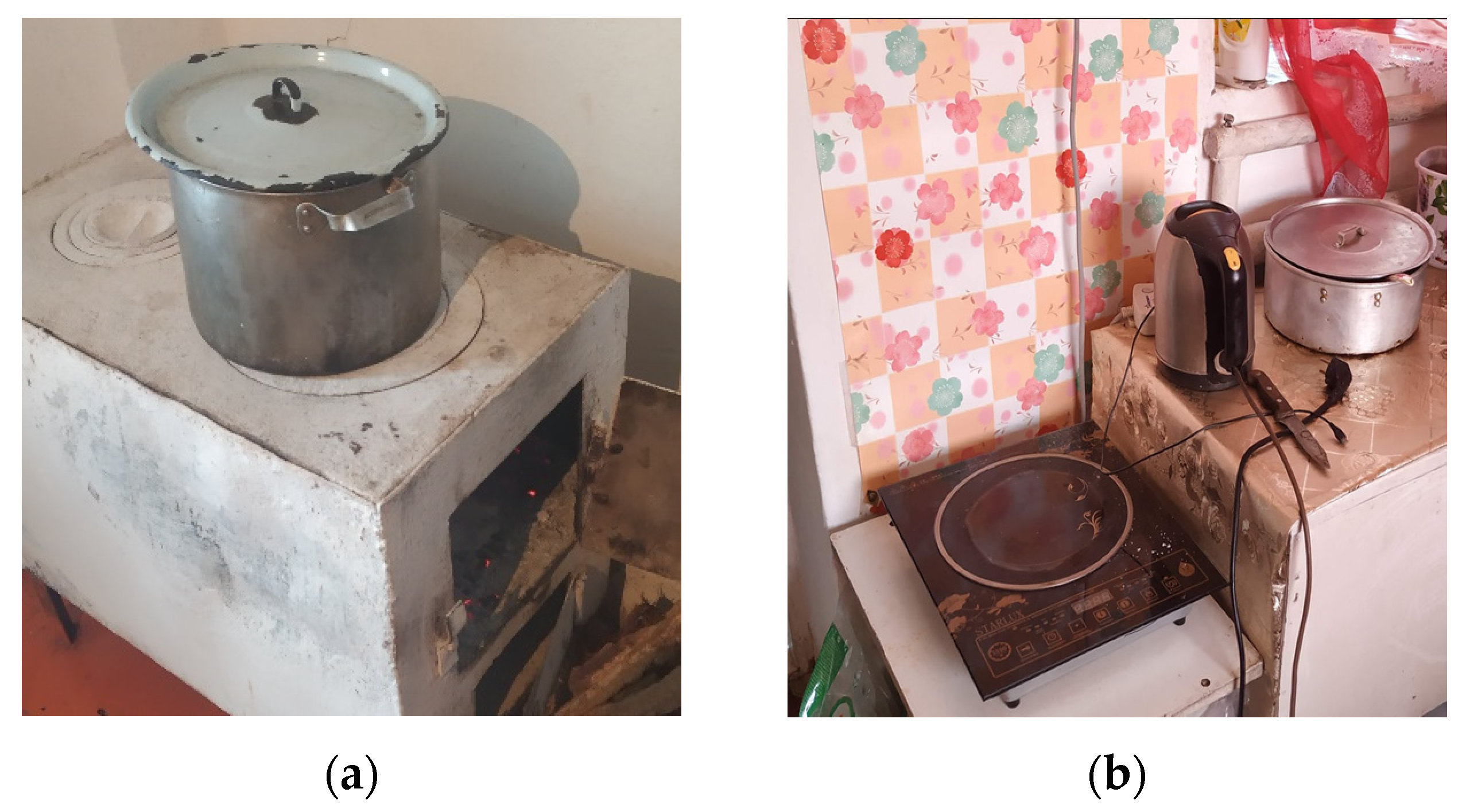
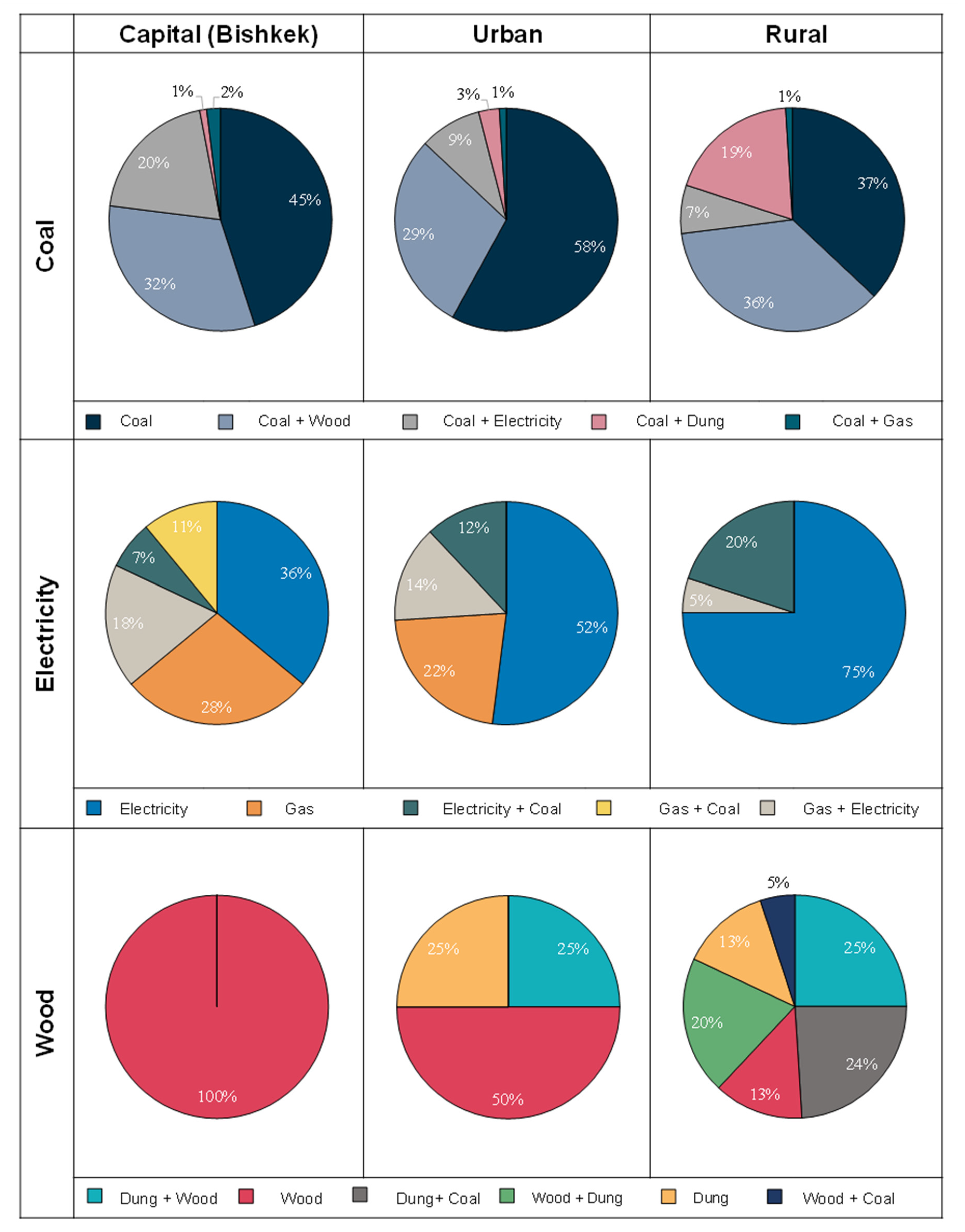
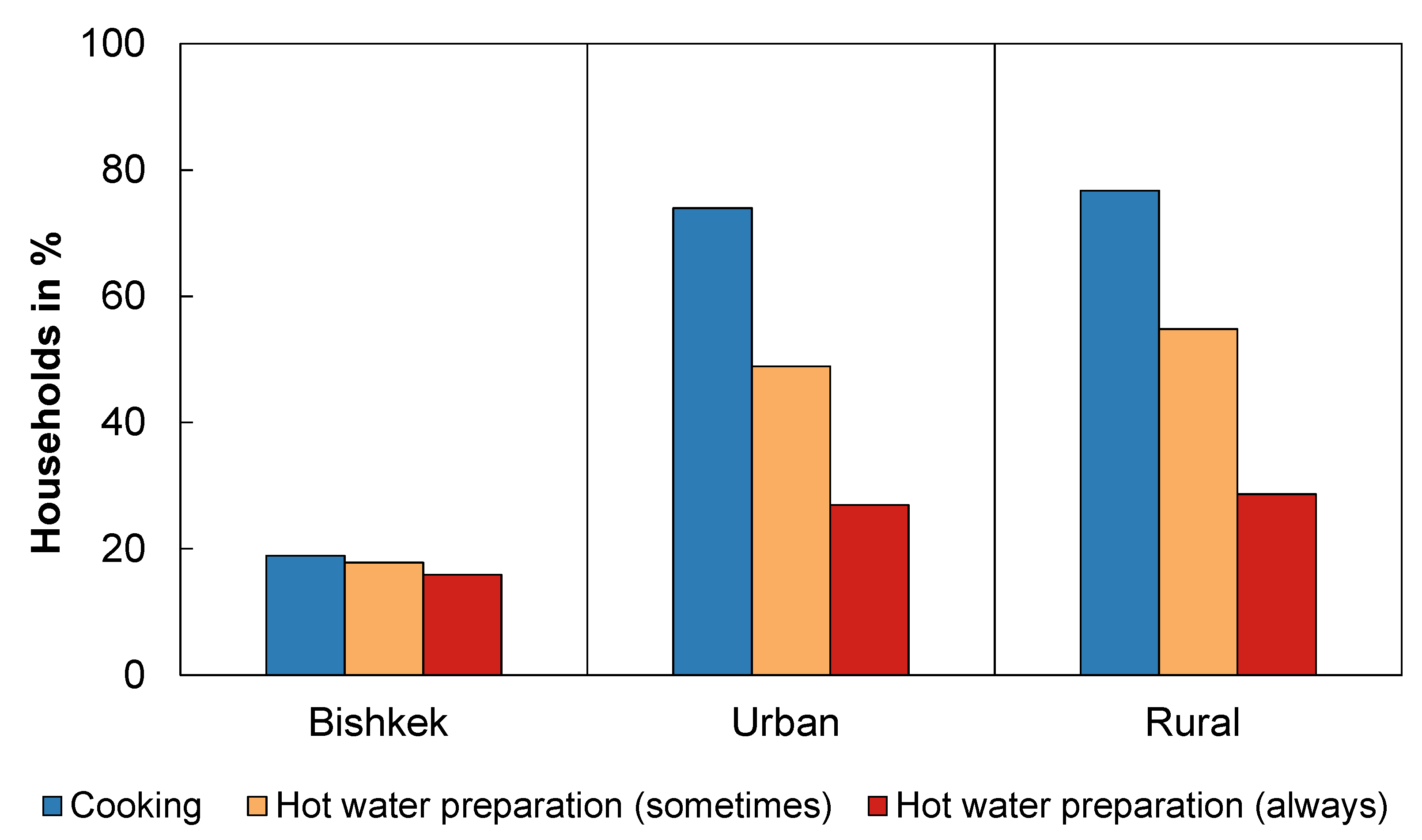

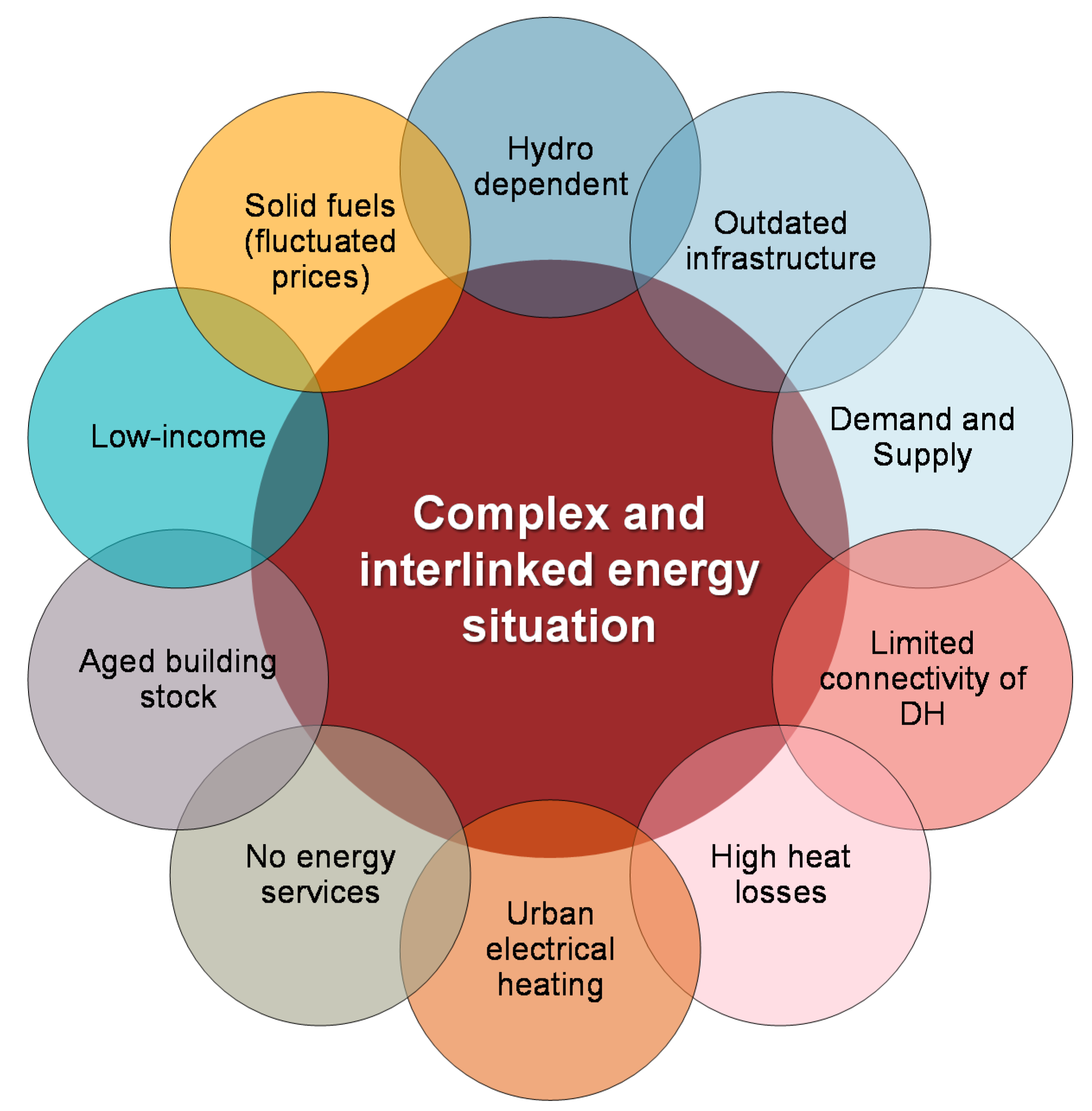
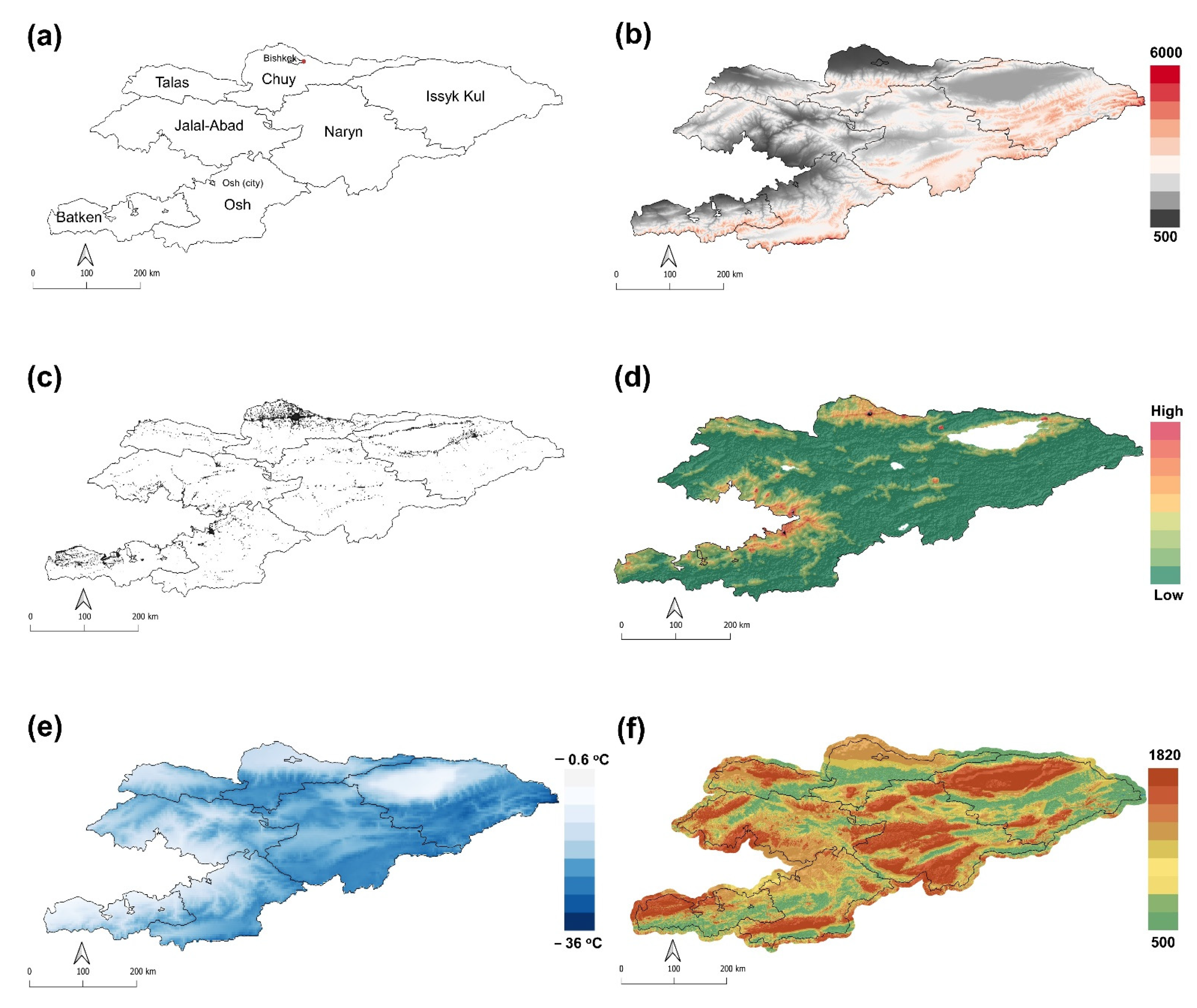
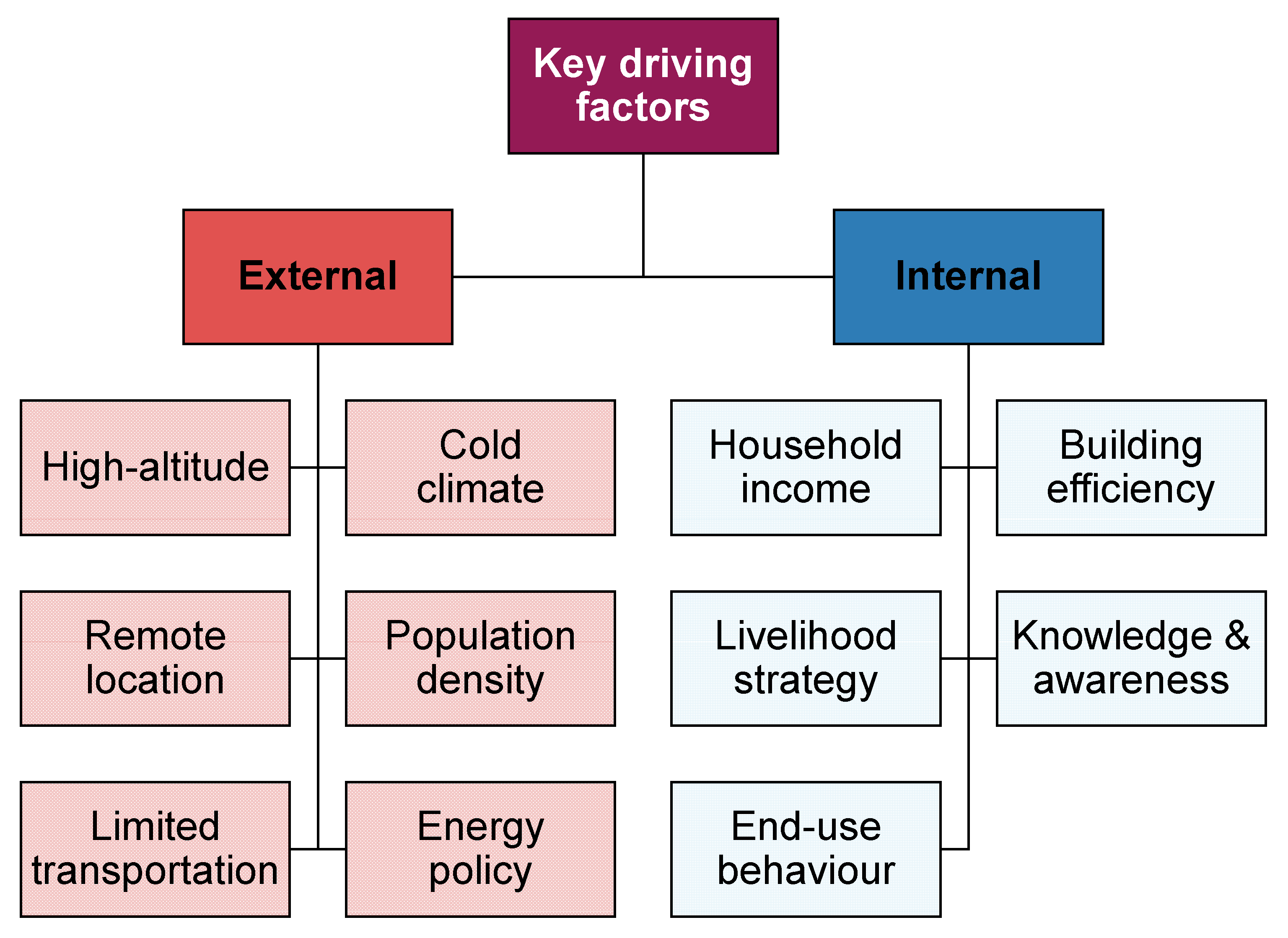
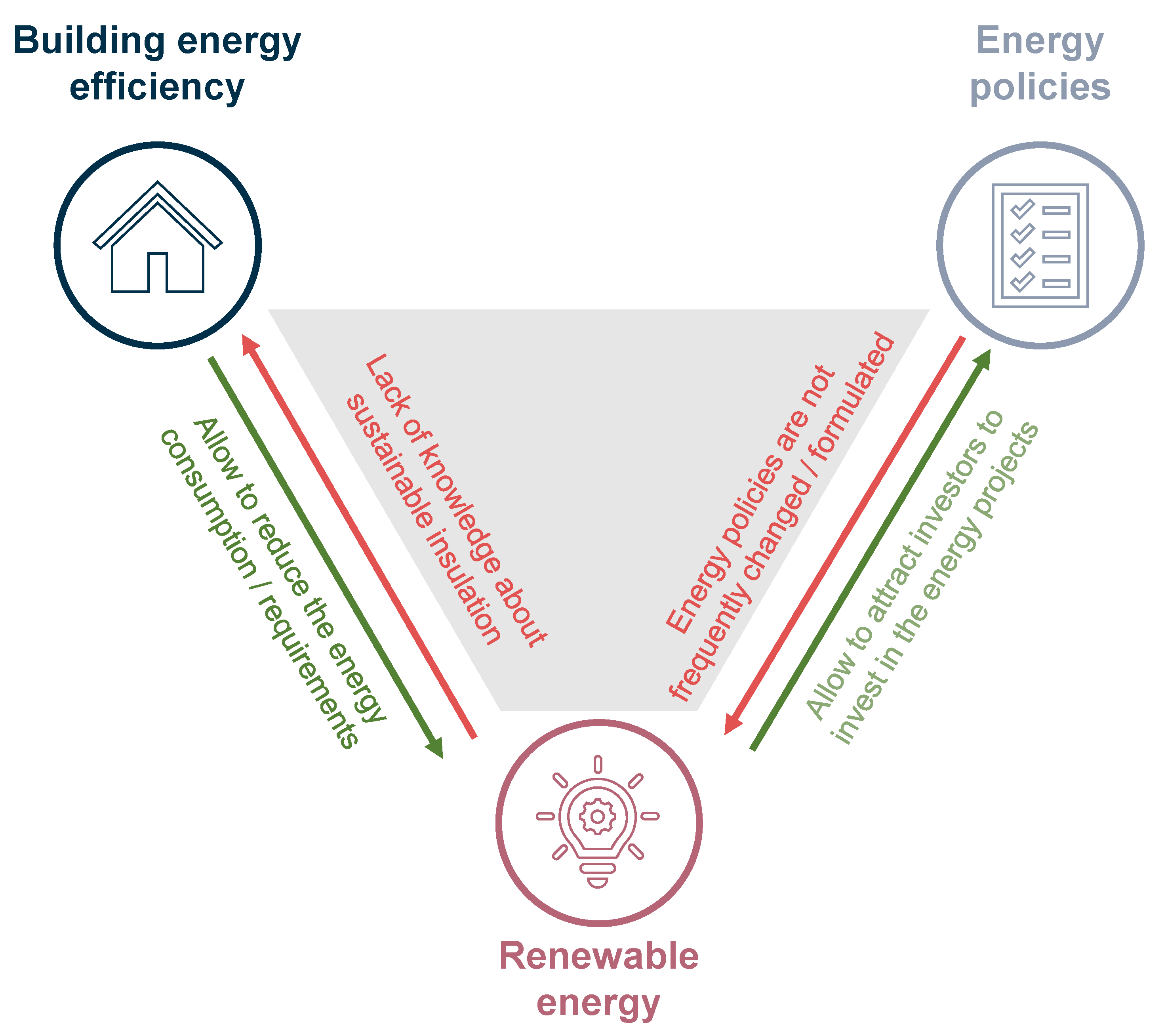
| Electricity | District Heating | Natural Gas and Others |
|---|---|---|
|
|
|
Publisher’s Note: MDPI stays neutral with regard to jurisdictional claims in published maps and institutional affiliations. |
© 2022 by the authors. Licensee MDPI, Basel, Switzerland. This article is an open access article distributed under the terms and conditions of the Creative Commons Attribution (CC BY) license (https://creativecommons.org/licenses/by/4.0/).
Share and Cite
Mehta, K.; Ehrenwirth, M.; Trinkl, C.; Zörner, W. Mapping Potential for Improving Rural Energy Services in Kyrgyzstan: Factors for Achieving Sustainable Development Goals in the Community Context. World 2022, 3, 586-606. https://doi.org/10.3390/world3030032
Mehta K, Ehrenwirth M, Trinkl C, Zörner W. Mapping Potential for Improving Rural Energy Services in Kyrgyzstan: Factors for Achieving Sustainable Development Goals in the Community Context. World. 2022; 3(3):586-606. https://doi.org/10.3390/world3030032
Chicago/Turabian StyleMehta, Kedar, Mathias Ehrenwirth, Christoph Trinkl, and Wilfried Zörner. 2022. "Mapping Potential for Improving Rural Energy Services in Kyrgyzstan: Factors for Achieving Sustainable Development Goals in the Community Context" World 3, no. 3: 586-606. https://doi.org/10.3390/world3030032
APA StyleMehta, K., Ehrenwirth, M., Trinkl, C., & Zörner, W. (2022). Mapping Potential for Improving Rural Energy Services in Kyrgyzstan: Factors for Achieving Sustainable Development Goals in the Community Context. World, 3(3), 586-606. https://doi.org/10.3390/world3030032






